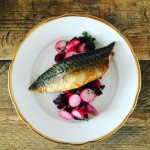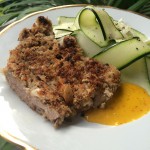The concept of writing a cookbook centred round leftovers is a tricky one. Largely because everyone amasses different leftovers in different ways.
The leftovers I usually end up with are a result of an impulse, market stall bargain. The kind which happen when tomatoes suddenly ripen. Farmers flog off this sudden glut of tomatoes to a stall holder, and in turn the market stall holder flogs it off to me at £1/5kg. Cheap fruit like this is usually just-turning, so once I’ve finished whooping with joy, I’ll carry my crate of tomatoes back home, and quickly use up half in a tomato sauce. Then a celebratory tomato salad. But then it’s round this point my enthusiasm can start to wane as I realise that I still have another 2kg of tomatoes to use, and it’s just the two of us living in the flat.
If, like me, your leftovers are dictated by the mass-purchase of cheap fruit and vegetables, (or, even better, the mass-ripening of fruit and vegetables in your allotment), then I think that you too will be enamoured by Tom Hunt’s debut cookbook, The Natural Cook.
Now, I should confess that I have a small bias towards Tom Hunt as the ‘Eco Chef’ was kind enough to do the cooking at our wedding this summer. I’m afraid that I was busy being all bridal, so didn’t have a camera to wield at supper, and forgot to ask anyone else to take any snaps. So you’ll just have to take my word that it was a sumptuous feast: roast pork belly with fennel and lemons; sardines with gremolata and aioli. And the unexpected star of the show being a puy lentil salad with sun-dried tomatoes, feta and watercress pesto. Never would I have predicated so many of my carnivorous friends polishing off a puy lentil salad with quite so much gusto, and praising it to high heaven. It was actually mentioned in several thank you letters. Good old lentils.
All the recipes are in The Natural Cook, a very cleverly-structured cookbook which arrived in the post earlier this week. Let me explain. It’s broken into seasonal chapters: spring, summer, autumn and winter. Each chapter has a handful of “seasonal heroes” – the kind which you might pick up at £2/10kg on Bethnal Green Road, if you’re lucky. Autumn, for example, is: carrots, beetroot, apples, pumpkins, celeriac, fennel, mushrooms and sweetcorn.
Each of these starring ingredients has a short preface. Beetroot, for example, is introduced as “a stout, rotund hero of the soil.” Enough to endear you to the vegetable before you start work on it. The preface is then followed by a handful of recipes which are designed to inspire rather than strictly instruct. Tom starts with a paragraph on boiling beetroot, and then some ideas of what to do with leftover boiled beetroot: beetroot ‘houmous’, borscht or a ‘Beetroot Nemesis’ cake.
Next is a paragraph on roasting beetroot. And then some ideas for using up leftover roast beetroot: ‘Roast beetroot, pak choi, labneh and cumin'; a beetroot, blue cheese, walnut and rocket salad; or the idea of mixing it with soy seeds and crispy seaweed for an Asian-inspired dish.
Then there is an interesting paragraph on candied beetroot – something I’ve never come across before. This is followed by a recipe for chocolate pots which use up the candied beetroot syrup, as well as the candied beetroot itself. And, just in case there are still any leftover candied beetroot slivers at the end of all this, some additional serving suggestions: “Top candied beetroot slices with soft goat’s cheese and serve as a canape, or just serve the slices with a cheese board.”
My fridge rotation is often dictated by one ingredient which is turned into something, thus creating a new leftover, which is then turned into something, thus creating a new leftover – and so on, and so forth. Somehow this is captured in Tom’s chapters, which tumble from one recipe into another, taking the sort of carrot scrapings which might – in some kitchens – have ended up in the dustbin, and turning them into something beautiful.
The Natural Cook pitches itself as “root to fruit”, which is my only small criticism, in terms of clarity. I thought that it would be veggie-only, but the title does it a disservice, as there are so many delicious meat and fish recipes, (salt fish and fennel börek ; and ox cheek and mushroom stew are next on my ‘to-cook’ list). The difference is that, unlike many other cook books, Tom uses fruit and vegetables as the starting point, and then thinks of meat or fish, rather than the other way round.
In conclusion, this is such a freeing and inspiring cookbook. On a bad day, leftovers can be a chore. But after reading The Natural Cook from cover to cover last night, I’ve got a strong urge to fill my fridge with bulk-market-buys, and actively create some leftovers so I can start exploring creative ways to use them up.
The Natural Cook: Eating the Seasons from Root to Fruit, Quadrille Publishing
Available at Amazon, £13.60
Sign up to Tom Hunt’s newsletter at: www.tomsfeast.com






Leave a Reply